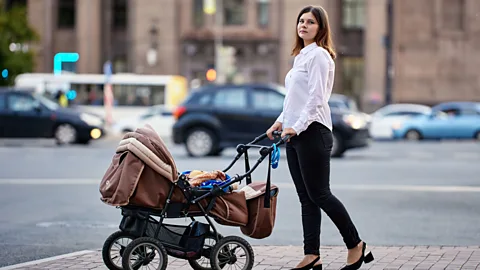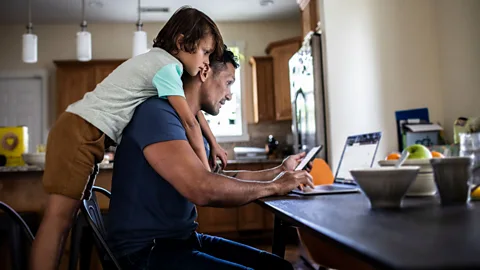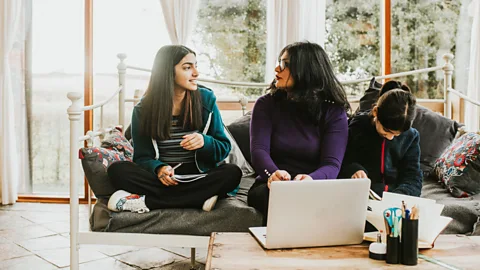Despite financial gains, some single parents are still in 'panic mode'

Single-parent households are growing rapidly. Some are better off financially than ever. That's not the case for everyone.
Single parents are a growing demographic across the world. The US has the most one-parent households of any nation in the world; more than 10 million, according to 2020 US Census Data, the most recent data available. Close to a quarter of American children live with just one parent. But these ranks are ticking up globally, too. A data analysis by the Organisation for Economic Co-operation and Development showed the number of sole-parent households was expected to rise across many of its 38 member countries.
"The consistency of the upward trend across these OECD countries is remarkable, with the bulk of projections to 2030 suggesting that numbers are likely to increase by between 22% and 29%," the report's authors wrote. The number of sole-parent households in Canada, for instance, has risen steadily throughout the past decade and a half, and the Australia Bureau of Statistics reported in 2021 that single-parent families were the fastest-growing family type in the country.
There are a number of drivers, say experts: globally, single parenthood numbers are rising as the divorce rate increases in many nations, particularly in some European and Asian countries. Research points to several other factors, including an altered socioeconomic landscape with increased female labour-market participation, and lessened stigma around single parenthood.
And as single parents now make up a large – and growing – share of the labour market, many of these families have seen their financial situations improve to the best point in decades. Yet these gains are not universal – and to support this large group of families across the world, there's still much work to do.
Good news – with a catch
Relying on a single income is almost always difficult, but data shows some improvement. In the US, a recent review of Federal Reserve Surveys of Consumer Finances shows that throughout the past three decades, US single parents' income has increased; home ownership and retirement savings have both gone up; and overall net worth for single-parent households has improved at a much faster rate than other Americans'.
"If we're looking strictly at growth, things have come a long way over the past 30 years for single-parent households," says Elizabeth Renter, a data analyst at American personal-finance company NerdWallet (and a single mum herself), who used the US Federal Reserve numbers to compile a January report on single-parent finances.
 Getty Images
Getty ImagesBetween 1992 and 2022 – the year of the most recent Federal Reserve Survey – she found median annual income in single-parent homes rose by 45%, compared to 27% for American households overall. Homeownership grew from 43% to 50%. The most dramatic numbers concern net worth: while American households overall saw an increase of 89%, the net worth of single-parent households shot up by 189%.
Yet the gains are not universal across the country. The Federal Reserve data reflects an enormous swath of Americans. Renter is keenly aware that while the numbers in her report draw a narrative of broad financial improvement, that does not reflect the lived experience of every single parent.
"I think those big aggregated national numbers mask some structural inequality," adds Vicki L Bogan, a professor of economics at Duke University's Sanford School of public policy. "If you look at single-parent households by race, there's some quite different statistics."
For instance, US Census data shows black and American Indian children are most likely to live in single-parent households. And while the poverty rate remains higher than the national average for single parents overall – in 2022, nearly 23% of female single-parent households and 11.5% of male single-parent households lived below the US poverty measure – being black or American Indian raises the odds of living in poverty even more. Nearly one-third of black families and one third of Latinx households headed by a single parent live in poverty. For households headed by a American Indian single-parent the number living in poverty rose to 43%. Twenty-six percent of white single-parent-led households lived at the poverty measure.
Outside the US, the growth of single parenthood has had the dual impact of increasing acceptance of "family diversity" and, in some places, influencing improved policy, says Catherine Jones, a lecturer in developmental psychopathology at King's College London. "In parts of Europe, there are amazing childcare facilities and parental leave," she says, "and in Scandinavian countries, you see really positive family policies."
Those social policies are a huge influence on families' financial stability. UCLA researchers looked at more than 370,000 households with children in 45 countries. They found while poverty levels among single parents are high regardless of geography, in nations that provide for maternity leave, poverty was significantly reduced.
Other, more direct assistance has an even greater impact. A 2022 paper from researchers at the University of Antwerp concluded "it is clearly possible to make sure that working single parents have minimally adequate incomes". Of more than two-dozen countries reviewed, single parents in the half the countries could reach or exceed the poverty threshold, largely thanks to child-benefit packages, such as pandemic-era policies including the UK's Universal Credit and the US's expanded Child Tax Credit, which have now expired.
However, in the absence of these programmes as permanent support, and even in nations with the most robust welfare systems, single parents are confronted with higher poverty risks. "Although things have improved," says Jones, "it's important that attention isn't shifted away from still trying to further improve policies for single parents."
'Work like every day is your last day'
Ultimately, there's still a lot of work to do to improve the financial situations of single parents – an imperative as this group grows.
One of the biggest stumbling blocks is what Rense Nieuwenhuis, an associate professor of sociology at Stockholm University's Swedish Institute for Social Research, calls the "triple bind". "Single parents and their families are disproportionally caught between inadequacies in resources, employment and policies," he wrote in in a 2018 book he co-edited on the subject.
 Getty Images
Getty ImagesWhen Crystal King, an HR professional living in Florida, US, decided to become a mother, she knew her growing family would be completely dependent on her income alone. "I'm a single mom by choice," says King. "I turned 35 and my partner at the time didn't want to have kids. So ultimately, becoming a single mom was my option, and I went full steam ahead, knowing I'd be the only provider."
It's not a decision she regrets, but it is one that's shifted her entire mentality around work and money. Now a mother of two children, aged six and three, King says she saves more aggressively and is more conscious of her liquidity – funnelling less to her 401k retirement account in case she needs to access the savings immediately – and works harder to stand out in her job.
"It makes me work differently," she says. "I hustle every single day to get as much done and create as big an impact as I possibly can. Before kids, you do your work, you chat around with people, you laugh, you go back to doing what you're doing. Now, I have a 'work like every day is your last day' kind of mentality."
More like this:
And money worries don't happen in a vacuum; stress often makes the overall experience of parenting harder. That's compounded, says Jones, for single parents, who already deal with higher levels of anxiety than the general population, according to a 2023 survey of 6,000 UK adults from the Mental Health Foundation.
"They're often the sole provider not just in terms of finances, but also in terms of care," she says. "Single parents often feel a huge responsibility for all of the parenting and all of the money. That makes a more challenging environment to parent in, and I think generally the bigger picture is it's not single parenthood, per se; it's factors like financial stress, rather than being a single parent in itself."
The same survey asked what would help alleviate the anxiety: "41% of anxious single parents said financial security, and a quarter (24%) said help with debt," according to the report.
And even for single parents in the labour market – a growing demographic – massive economic hurdles still exist for them to find parity with dual-income families. "Employment is certainly not a guarantee against poverty. At least in the EU, we've seen an increase in the employment of single parents, but hardly a decrease in relative income poverty," says Nieuwenhuis. And even making more money doesn't necessarily shift single parents' financial situation "in an absolute sense", he adds. "It might not be enough. In dual-earner societies such as Sweden, as a single earner it's really hard to keep up with those dual earners."
There's an undercurrent of financial anxiety to single parenthood that never goes away, says NerdWallet's Renter, regardless of income. "Personally, it still affects me," she says. "I think of who I was when my daughter was young, and the fear and anxiety surrounding my personal finances. It's still there, beneath the surface, and that's impacted how I deal with money and how I think about money, even though I'm pretty secure now."
King agrees. While she is happy and comfortable in her current job, she still also worries her situation is hanging by a thread, especially in the current economy. "When you have a partner's income, it gives you a longer runway to find [a new job] without the situation being critical or devastating. For me, the moment I lose a job, it's panic mode."
--
If you liked this story, sign up for The Essential List newsletter – a handpicked selection of features, videos and can't-miss news delivered to your inbox every Friday.
